Key takeaways:
- Consumer protection principles, such as the right to safety and the right to be informed, are essential for building trust in the marketplace.
- Storytelling enhances safety awareness by making complex issues relatable and creating memorable narratives that encourage community engagement.
- Sharing personal consumer experiences fosters a sense of community and empowers individuals to make informed purchasing decisions.
- The impact of storytelling in consumer awareness is measured not just by audience reach but by changes in behavior and deeper understanding among listeners.
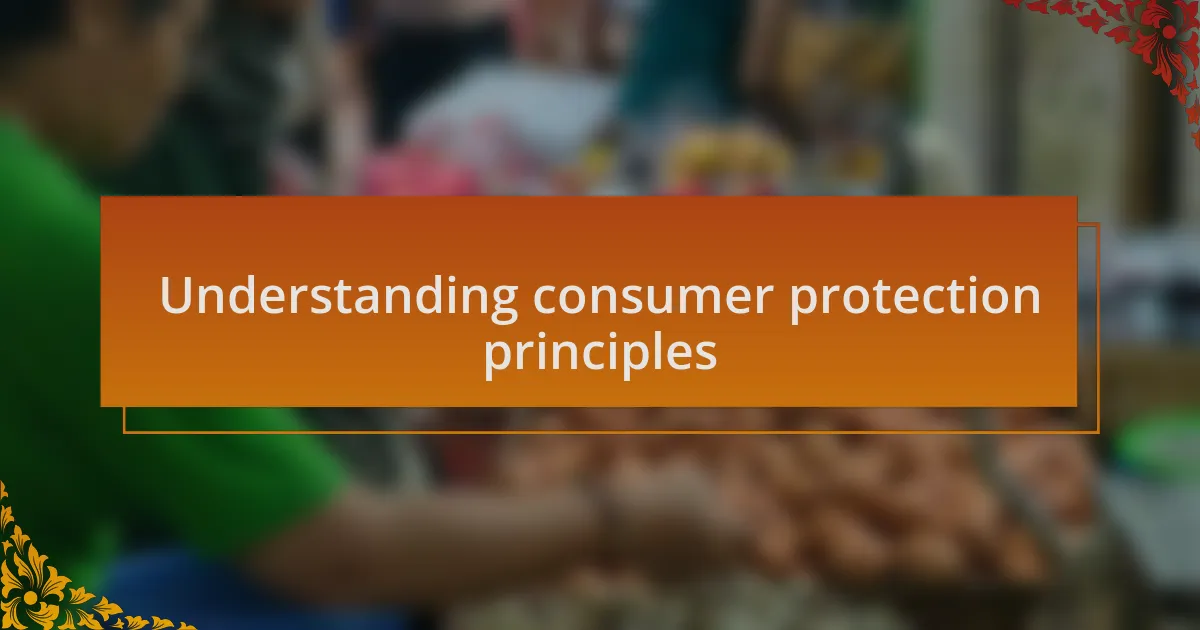
Understanding consumer protection principles
Consumer protection principles serve as the backbone of a fair marketplace, ensuring that buyers can trust what they purchase. I recall a time when I was misled by a product advertisement that overstated the benefits of a gadget. This experience made me acutely aware of how critical it is for consumers to have transparent information and the right to fair treatment.
One crucial principle is the right to safety, which resonated deeply with me after hearing about a friend who suffered injuries from a faulty product. Imagine having to navigate a world where safety is not guaranteed—it’s frightening. This principle helps consumers feel secure, knowing that the products they buy meet safety standards.
Another fundamental aspect is the right to be informed. This right allows consumers to make educated choices based on accurate information. I often reflect on how empowering it felt to finally understand the fine print in service contracts after researching it thoroughly. Have you ever felt overwhelmed by technical jargon? Consumer protection principles aim to eliminate that intimidation, allowing everyone, regardless of their background, to confidently participate in the marketplace.
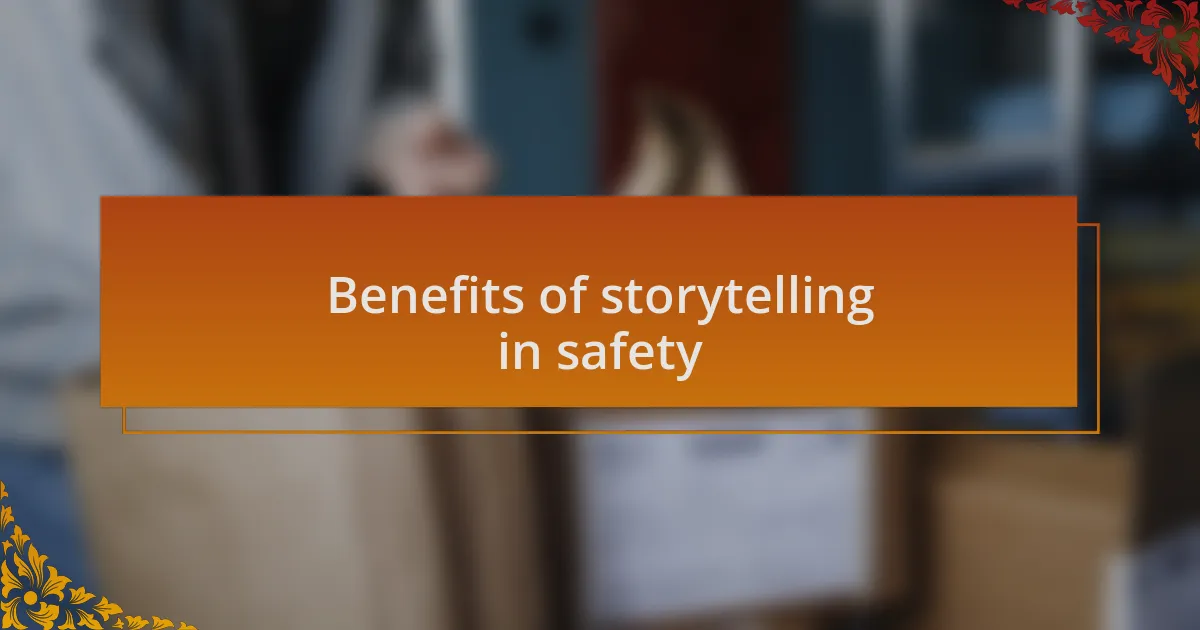
Benefits of storytelling in safety
Storytelling plays a vital role in fostering safety by making complex concepts more relatable. I once attended a safety workshop where case studies transformed dry safety statistics into compelling narratives. By hearing about real people and their experiences with unsafe products, I couldn’t help but feel a deep connection to the stories. It was a stark reminder that safety isn’t just about rules and regulations; it’s about real lives impacted by choices.
Another significant benefit of storytelling in safety is its ability to create a memorable impact. I still remember a harrowing tale shared during a community meeting about a family affected by a defective appliance. The emotional weight of that story stayed with me, making me more vigilant about safety checks in my own home. Can you recall a story that changed your perspective on safety? These narratives not only educate but also inspire us to take action, reinforcing the importance of being safety-conscious.
Moreover, storytelling encourages community engagement by inviting individuals to share their personal experiences. When I’ve shared my own close call with an unsafe product, others opened up about theirs, creating a space for collective learning. How many of us have learned important safety lessons from a friend’s story? This exchange not only enhances our understanding but also fosters a culture of safety awareness that can ripple outwards, empowering more consumers to prioritize their wellbeing.
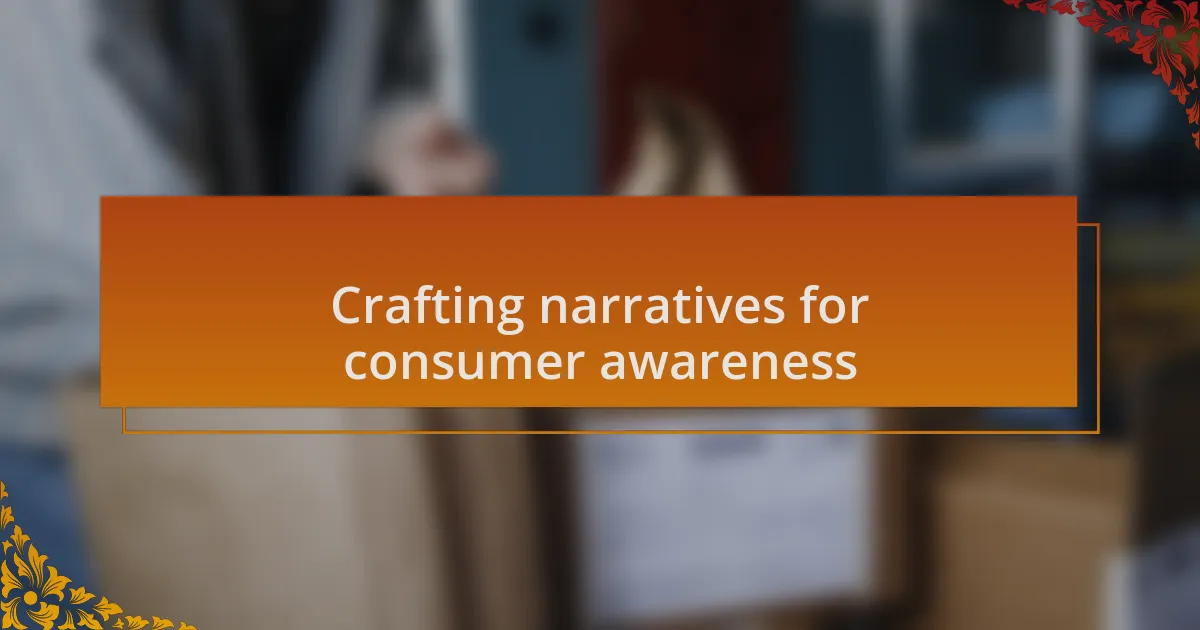
Crafting narratives for consumer awareness
Crafting narratives for consumer awareness involves weaving relatable stories that resonate with the audience. I distinctly remember a time when a friend shared her experience with a misleading product advertisement. Her frustration and disappointment were palpable as she recounted not just the financial loss, but the sense of betrayal she felt. It made me reflect on how easily we can be swayed by marketing tactics that don’t always have our best interests at heart. Isn’t it unsettling to think how vulnerable we all can be?
When I immerse myself in stories that highlight consumer issues, I realize just how powerful these narratives can be in raising awareness. For instance, a blog post I read about a family who unknowingly purchased a counterfeit car part really struck me. The blend of personal struggle and practical advice made me rethink my own purchasing habits. It’s fascinating how stories can not only highlight potential dangers but also prompt consumers to scrutinize their choices more critically.
I believe that sharing these narratives fosters a sense of community and empowerment among consumers. When I joined a local forum and listened to others recount their experiences with product failures, it felt like we were building a collective shield of knowledge. Have you ever walked away from a discussion about consumer rights feeling more informed and ready to act? Those moments of shared vulnerability can turn stories into a powerful tool for awareness, prompting us all to become more proactive in protecting ourselves and each other.
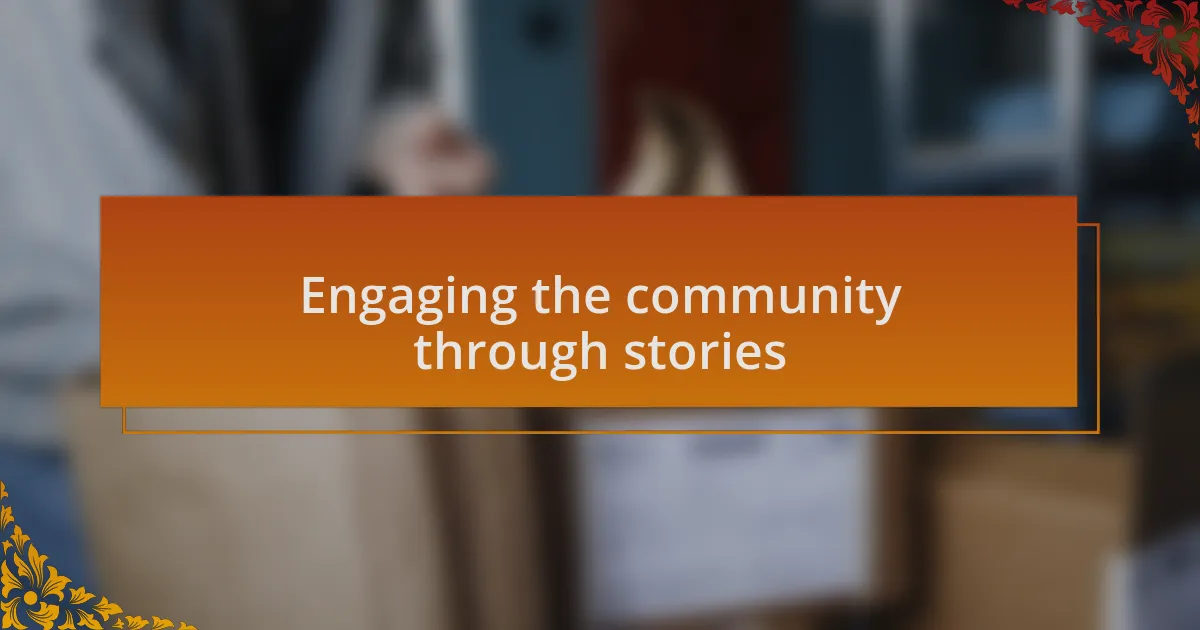
Engaging the community through stories
Engaging the community through stories allows us to connect on a deeper level, transforming individual experiences into collective wisdom. I recall attending a community meeting focused on consumer safety, where a local business owner shared his experience of being scammed by a supplier. The look on his face conveyed the real impact of his loss—not just financial, but emotional. Hearing him speak made everyone in the room pause and reflect: how often do we put trust in people we don’t know?
I find that when stories circulate within a community, they serve as cautionary tales that can influence behavior. For instance, one afternoon, I heard a neighbor describe how a seemingly harmless online purchase led to identity theft. I was stunned and couldn’t help but think about my own online habits. That simple story changed the way I approach online shopping, reinforcing the idea that we need to share these narratives not just for information, but to safeguard each other.
Every time we share a personal story, it strengthens our community ties and builds a culture of safety. A few months ago, after I shared a troubling experience with a defective product, several others chimed in with their similar encounters. It was eye-opening to see the collective resolve to make informed choices. I wonder, how many more stories are waiting to be told that could help us all navigate the often murky waters of consumerism?
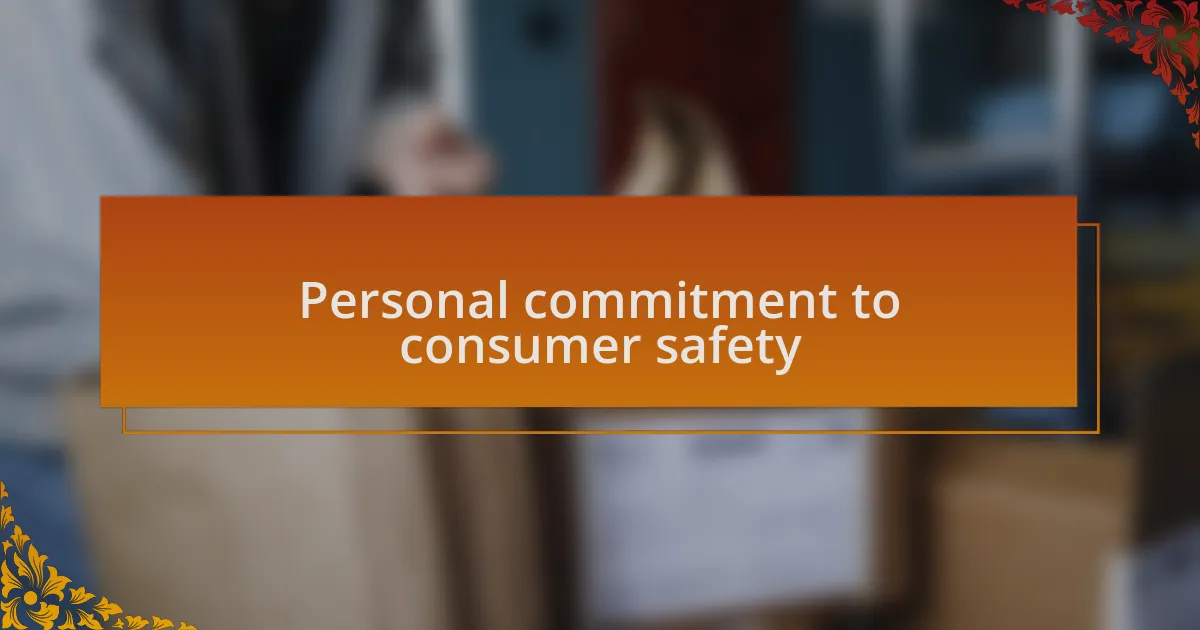
Personal commitment to consumer safety
Personal commitment to consumer safety is something I take to heart. Recently, I assisted a friend who faced difficulties when a product he bought turned out to be counterfeit. Helping him navigate the return process not only reinforced my belief in advocating for consumer rights but also reminded me of how vulnerable we can be in this vast marketplace. Have you ever felt that sinking feeling when you realize you’ve been deceived?
Reflecting on past experiences, I recall a time when I uncovered a false advertisement for a popular service that many of my peers were considering. It disturbed me not just because of the misleading claims but because I felt a duty to inform others. So, I organized an informal discussion group to share our findings. This small act created a ripple effect, prompting everyone to rethink the sources they trust when making decisions. Isn’t it fascinating how a little knowledge shared can empower us all?
In my journey as a consumer, I strive to lead by example. A few years back, I saved money by purchasing a seemingly great deal online, but the quality was dismal. I decided to write a review, not just to vent frustration but to serve as a warning. My experience resonated with those who read it, generating conversations on the importance of thoughtful purchases. We all bear the responsibility of fostering a safer consumer environment, don’t we?
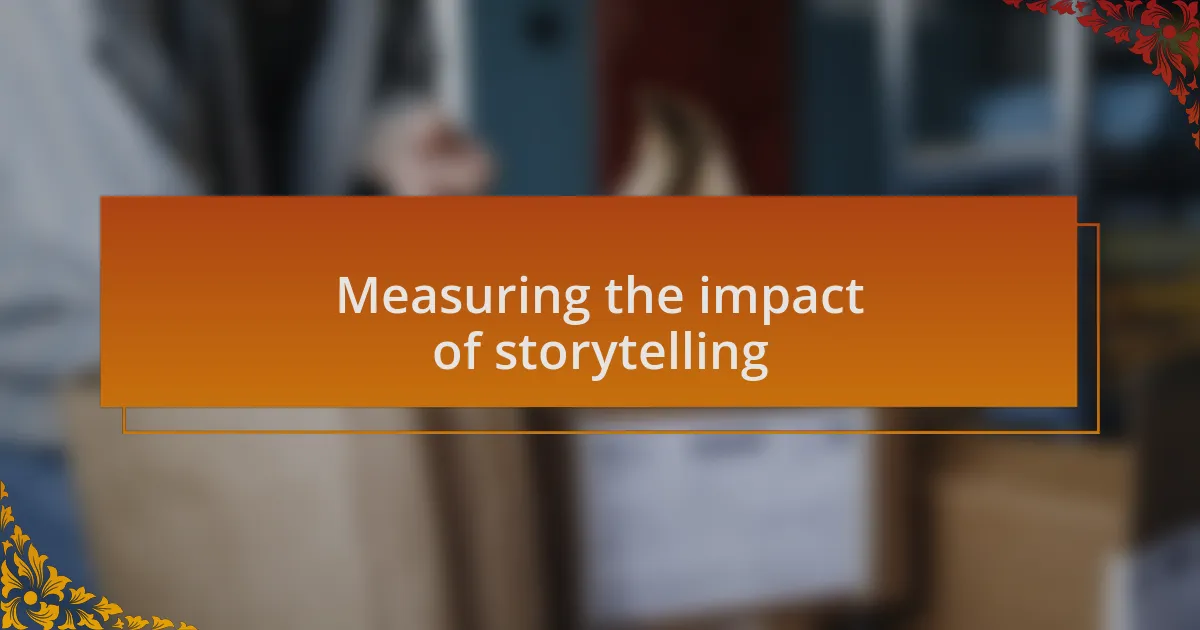
Measuring the impact of storytelling
Measuring the impact of storytelling can often feel intangible, yet its effects are profound. I remember sharing a personal narrative about a product that failed to meet expectations during a community event. The way people responded, nodding and relating their own experiences, showed me that storytelling had sparked a deeper understanding and connection among us. Have you witnessed the power of a shared story to illuminate a common concern?
What struck me was the shift in attitudes following these exchanges. One attendee approached me afterwards, expressing how my story had inspired him to become more vigilant in his purchasing habits. Seeing someone take action based on what I shared made me realize that storytelling can be a catalyst for change, encouraging individuals to scrutinize their choices more critically. Isn’t it amazing how a simple tale can transform one’s perspective?
As I reflect on these moments, I understand that measuring impact isn’t solely about counting how many people hear the story; it’s also about observing changes in behaviors and attitudes. For me, the real measure lies in the conversations that unfold, the questions that arise, and the collective awareness that grows. Have you ever felt that moment when you know your story resonated, making a tangible difference?